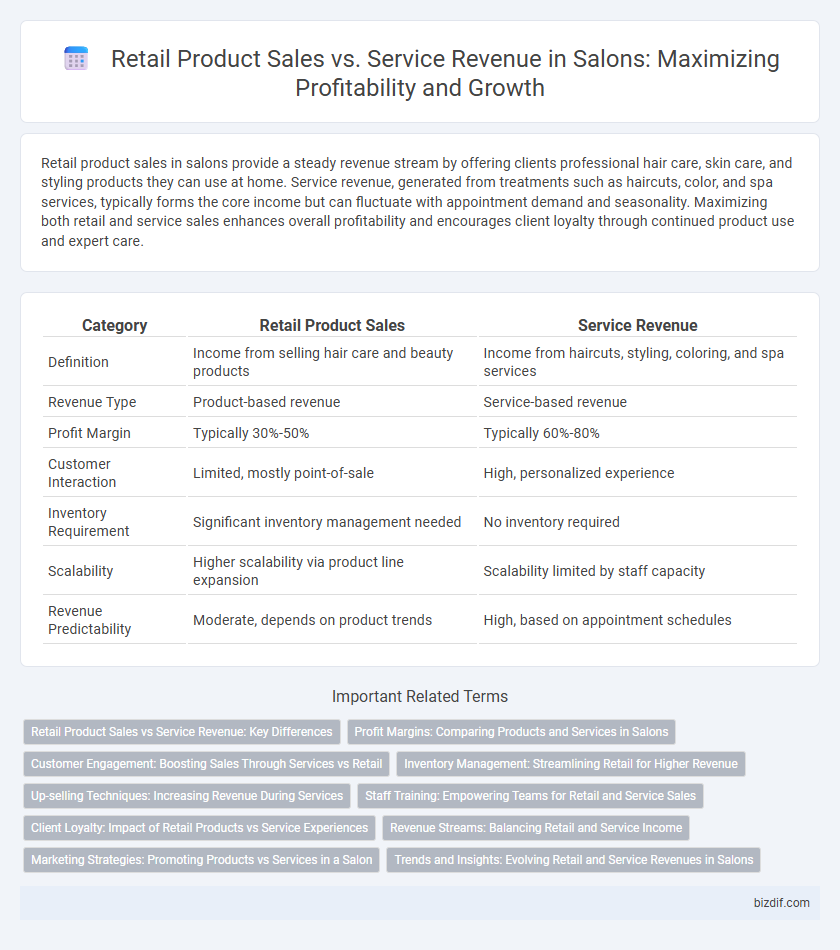Retail product sales in salons provide a steady revenue stream by offering clients professional hair care, skin care, and styling products they can use at home. Service revenue, generated from treatments such as haircuts, color, and spa services, typically forms the core income but can fluctuate with appointment demand and seasonality. Maximizing both retail and service sales enhances overall profitability and encourages client loyalty through continued product use and expert care.
Table of Comparison
| Category | Retail Product Sales | Service Revenue |
|---|---|---|
| Definition | Income from selling hair care and beauty products | Income from haircuts, styling, coloring, and spa services |
| Revenue Type | Product-based revenue | Service-based revenue |
| Profit Margin | Typically 30%-50% | Typically 60%-80% |
| Customer Interaction | Limited, mostly point-of-sale | High, personalized experience |
| Inventory Requirement | Significant inventory management needed | No inventory required |
| Scalability | Higher scalability via product line expansion | Scalability limited by staff capacity |
| Revenue Predictability | Moderate, depends on product trends | High, based on appointment schedules |
Retail Product Sales vs Service Revenue: Key Differences
Retail product sales in salons typically generate immediate revenue through the sale of shampoos, conditioners, styling tools, and skincare items, offering clients take-home solutions that complement in-salon treatments. Service revenue is driven by appointments for haircuts, coloring, treatments, and spa services, reflecting ongoing client engagement and expertise delivery. Understanding these key differences enables salons to optimize inventory management and marketing strategies to balance product sales with personalized service income.
Profit Margins: Comparing Products and Services in Salons
Retail product sales in salons typically yield higher profit margins, often ranging between 50% to 70%, compared to service revenue, which averages around 30% to 50%. Products like haircare and skincare items provide consistent upselling opportunities and recurring income with minimal labor costs. Service revenue, while essential for customer retention, involves variable expenses such as labor and supplies, which reduce overall profitability compared to retail product sales.
Customer Engagement: Boosting Sales Through Services vs Retail
Customer engagement in salons significantly impacts retail product sales and service revenue, with personalized consultations during services driving higher product purchases. Clients who experience tailored treatments often trust experts' recommendations, increasing their likelihood to buy retail products for at-home care. Fostering strong client relationships through exceptional service enhances overall revenue by creating opportunities for cross-selling and repeat business.
Inventory Management: Streamlining Retail for Higher Revenue
Effective inventory management in salons optimizes retail product sales by maintaining the right stock levels of high-demand beauty products, directly boosting revenue without overstock risks. Integrating point-of-sale systems with real-time inventory tracking allows salons to identify top-selling items and adjust purchases accordingly, enhancing both customer satisfaction and profitability. Streamlined inventory processes reduce carrying costs and enable targeted promotions, ultimately increasing retail revenue relative to service earnings.
Up-selling Techniques: Increasing Revenue During Services
Salon professionals boost retail product sales by integrating targeted up-selling techniques during service appointments, such as recommending complementary hair care products tailored to clients' specific needs. Utilizing personalized consultations enhances customer trust and encourages higher product adoption, directly increasing overall revenue. Effective staff training in communication and product knowledge is critical to maximizing both service satisfaction and retail sales conversion rates.
Staff Training: Empowering Teams for Retail and Service Sales
Effective staff training enhances both retail product sales and service revenue by equipping salon teams with product knowledge and personalized selling techniques. Empowered employees confidently recommend retail items aligned with clients' service needs, boosting overall revenue streams. Continuous education on new trends and customer engagement strategies fosters a seamless integration of retail and service sales in the salon environment.
Client Loyalty: Impact of Retail Products vs Service Experiences
Retail product sales in salons significantly enhance client loyalty by offering tangible take-home benefits that extend the salon experience beyond the visit. Service revenue drives immediate satisfaction through personalized treatments, but retail products create ongoing brand engagement and trust. Salons that strategically balance retail offerings with high-quality service experiences foster stronger client retention and increased lifetime value.
Revenue Streams: Balancing Retail and Service Income
Retail product sales contribute significantly to a salon's revenue streams by providing consistent income through the sale of hair care, skincare, and styling products. Service revenue, including haircuts, coloring, and spa treatments, often generates higher profit margins and drives customer loyalty. Balancing retail and service income ensures diversified revenue, stabilizes cash flow, and maximizes overall profitability in competitive salon markets.
Marketing Strategies: Promoting Products vs Services in a Salon
Boosting retail product sales in salons requires targeted marketing strategies such as in-store promotions, loyalty programs, and personalized product recommendations by stylists. Service revenue growth benefits from highlighting expertise through social media tutorials, client testimonials, and exclusive service packages that emphasize value and experience. Integrating retail and service marketing creates a cohesive brand message, increasing overall customer engagement and maximizing salon profitability.
Trends and Insights: Evolving Retail and Service Revenues in Salons
Salon retail product sales have seen a steady rise, driven by consumer demand for professional-grade haircare and skincare items. Service revenue remains the primary income source, but salons increasingly integrate product sales to boost profit margins and client loyalty. Data reveals a growing trend where personalized product recommendations during services lead to higher retail conversion rates and enhanced overall revenue streams.
Retail Product Sales vs Service Revenue Infographic

 bizdif.com
bizdif.com